
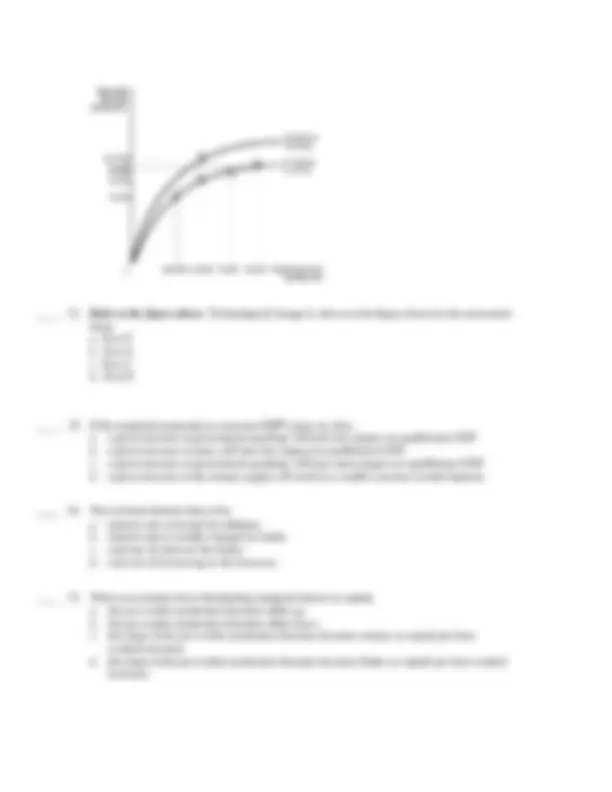
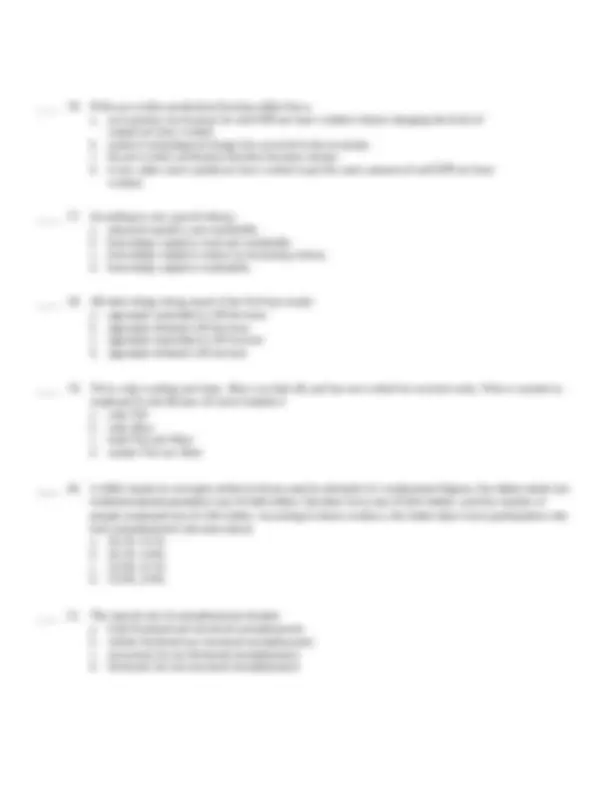
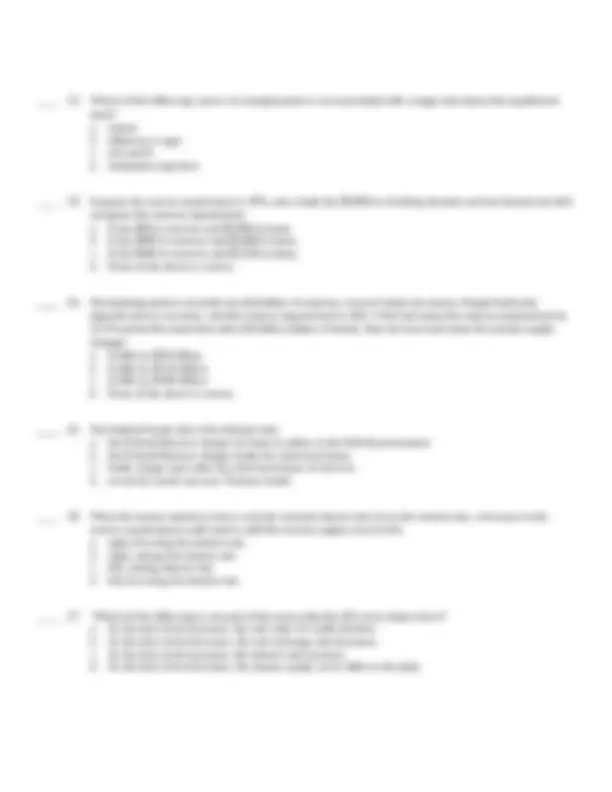
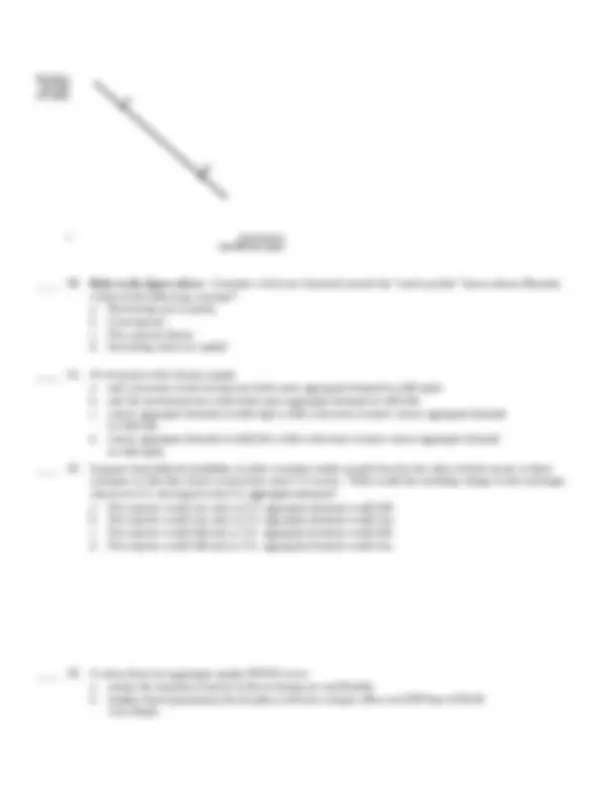
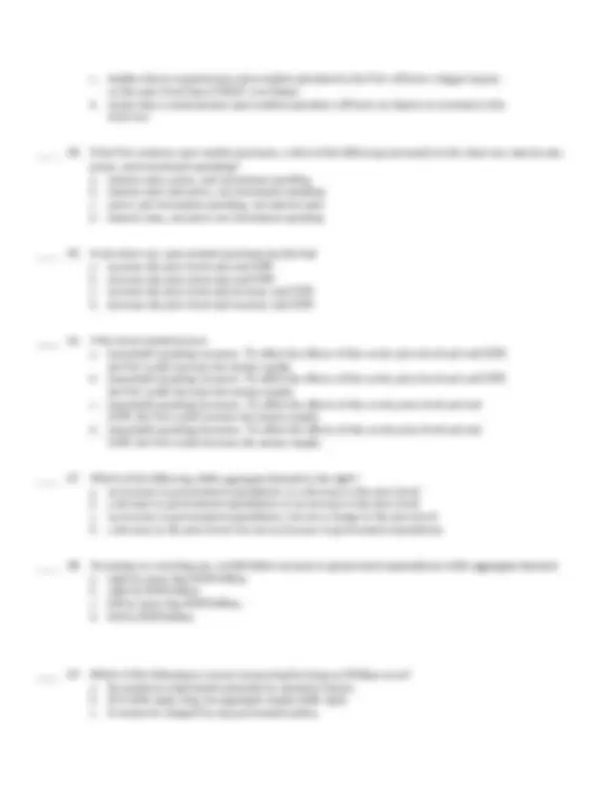
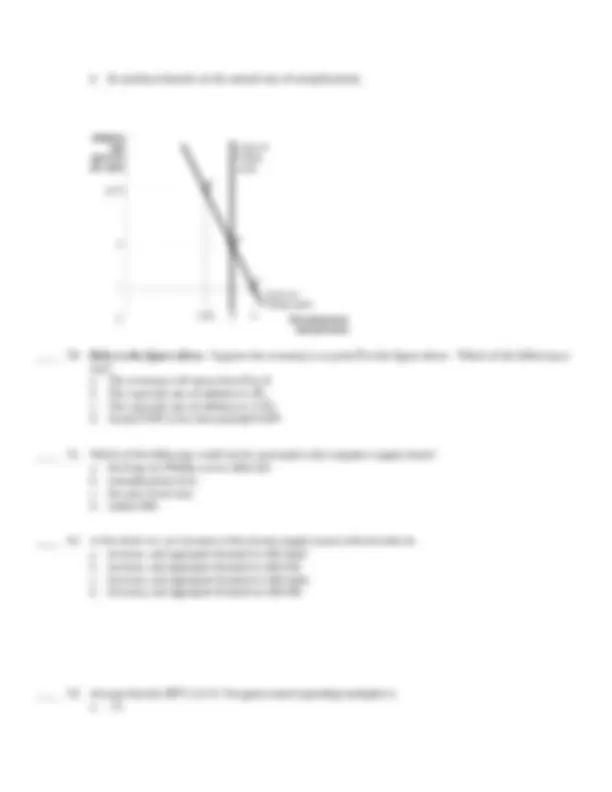

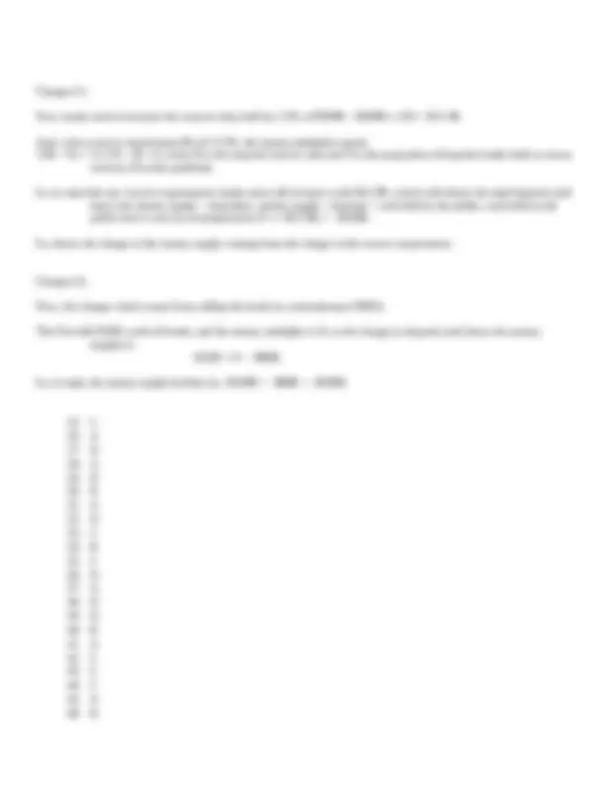
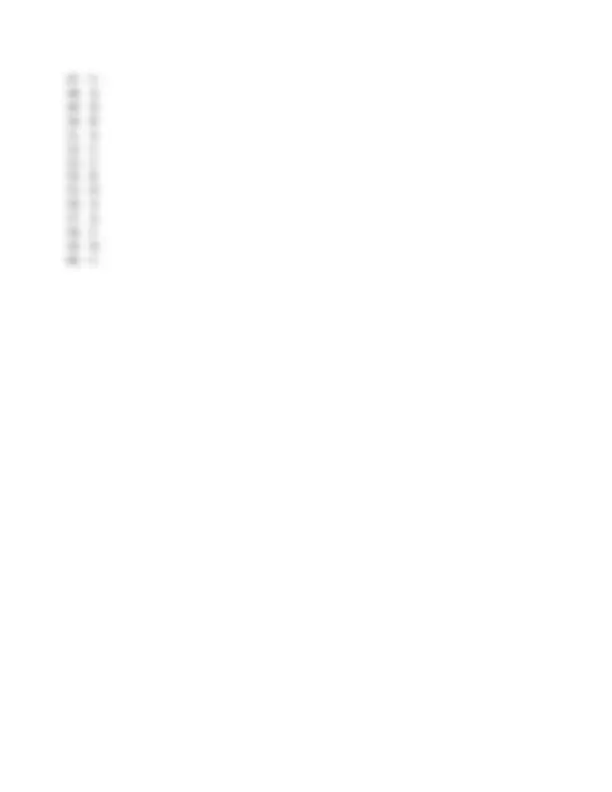


Study with the several resources on Docsity

Earn points by helping other students or get them with a premium plan


Prepare for your exams
Study with the several resources on Docsity

Earn points to download
Earn points by helping other students or get them with a premium plan
Community
Ask the community for help and clear up your study doubts
Discover the best universities in your country according to Docsity users
Free resources
Download our free guides on studying techniques, anxiety management strategies, and thesis advice from Docsity tutors
final macro econ practise quiz
Typology: Quizzes
1 / 15

This page cannot be seen from the preview
Don't miss anything!










____ 1. Which of the following examples of production would count as part of U.S. GDP? a. Samantha, a Canadian citizen, grows sweet corn in Minnesota and sells it to a grocery store in Canada. b. Ian, an American citizen, grows peaches for his family in the back yard of their Atlanta home. c. Brian, an American citizen, grows marijuana in Mexico and sells it in Europe d. None of the above examples of production would count as part of U.S. GDP. ____ 2. If a small country has current nominal GDP of $25 billion and the GDP deflator is 125, what is real GDP? a. $200 million b. $207.5 billion c. $31.25 billion d. $20 billion ____ 3. The economy's inflation rate is the a. price level in the current period. b. change in the price level from the previous period. c. change in nominal GDP from the previous period. d. percentage change in the price level from the previous period. ____ 4. In the CPI, goods and services are weighted according to a. how long a market has existed for each good or service. b. the extent to which each good or service is regarded by the government as a necessity. c. how much consumers buy of each good or service. d. the number of firms that produce and sell each good or service. Table 24- Year Peaches Pecans 2005 $11 per bushel $6 per bushel 2006 $9 per bushel $10 per bushel ____ 5. Refer to Table 24-1. Suppose the typical consumer basket consists of 10 bushels of peaches and 15 bushels of pecans. Using 2005 as the base year, the CPI for 2006 is a. 100. b. 120. c. 200. d. 240.
____ 6. Assume an economy experienced a higher inflation rate, as measured by the CPI, between 2004 and 2005 than it experienced between 2003 and 2004. Which of the following scenarios is consistent with this assumption? a. The CPI was 100 in 2003, 110 in 2004, and 120 in 2005. b. The CPI was 100 in 2003, 110 in 2004, and 124 in 2005. c. The CPI was 110 in 2003, 150 in 2004, and 200 in 2005. d. All of the above are correct. ____ 7. Babe Ruth's 1931 salary was $80,000. Government statistics show a consumer price index of 15.2 for 1931 and 195 for 2005. Ruth's 1931 salary was equivalent to a 2005 salary of about a. $536,000. b. $828,000. c. $1,026,000. d. $1,216,000. ____ 8. During the past century the average growth rate of U.S. real GDP per person was about 2%. This implies that it doubled about every a. 100 years. b. 70 years. c. 35 years. d. 25 years. ____ 9. The level of real GDP per person a. differs widely across countries, but the growth rate of real GDP per person is similar across countries. b. is very similar across countries, but the growth rate of real GDP per person differs widely across countries. c. and the growth rate of real GDP per person are similar across countries. d. and the growth rate of real GDP per person vary widely across countries. ____ 10. If a country’s saving rate declined, holding other factors constant, in the long run it would have a. lower productivity, but not a lower growth rate. b. lower productivity and a lower growth rate. c. a lower growth rate, but not lower productivity. d. neither lower productivity nor a lower growth rate. ____ 11. An increase in the savings rate would, other things being equal, a. increase growth more for a poor country than for a rich country, and raise the growth rate permanently. b. increase growth more for a poor country than for a rich country, but raise the growth rate only temporarily. c. increase growth more for a rich country than a poor country, and raise the growth rate permanently. d. increase growth more for a rich country than a poor country, but raise the growth rate only temporarily.
____ 16. If the per-worker production function shifts down, a. an economy can increase its real GDP per hour worked without changing the level of capital per hour worked. b. positive technological change has occurred in the economy. c. the per-worker production function becomes steeper. d. it now takes more capital per hour worked to get the same amount of real GDP per hour worked. ____ 17. According to new growth theory, a. physical capital is non-excludable. b. knowledge capital is rival and excludable. c. knowledge capital is subject to increasing returns. d. knowledge capital is excludable. ____ 18. All other things being equal, if the Fed buys bonds a. aggregate expenditure will decrease. b. aggregate demand will decrease. c. aggregate expenditure will increase d. aggregate demand will increase ____ 19. Ted is only working part time. Alice was laid off, and has not worked for several weeks. Who is counted as employed by the Bureau of Labor Statistics? a. only Ted b. only Alice c. both Ted and Alice d. neither Ted nor Alice ____ 20. In 2004, based on concepts similar to those used to estimate U.S. employment figures, the Italian adult non- institutionalized population was 45.020 million, the labor force was 24.065 million, and the number of people employed was 22.105 million. According to these numbers, the Italian labor-force participation rate and unemployment rate were about a. 45.1%, 8.1% b. 45.1%, 4.4% c. 53.5%, 8.1% d. 53.5%, 4.4% ____ 21. The natural rate of unemployment includes a. both frictional and structural unemployment. b. neither frictional nor structural unemployment. c. structural, but not frictional unemployment. d. frictional, but not structural unemployment.
____ 22. Which of the following causes of unemployment is not associated with a wage rate above the equilibrium level? a. unions b. efficiency wages c. job search d. minimum-wage laws ____ 23. Suppose the reserve requirement is 10%, and a bank has $4,000 in checking deposits and has loaned out all it can given the reserve requirement. a. It has $40 in reserves and $3,960 in loans. b. It has $400 in reserves and $3,600 in loans. c. It has $444 in reserves and $3,556 in loans. d. None of the above is correct. ____ 24. The banking system currently has $50 billion of reserves, none of which are excess. People hold only deposits and no currency, and the reserve requirement is 10%. If the Fed raises the reserve requirement to 12.5% and at the same time sells $10 billion dollars of bonds, then by how much does the money supply change? a. It falls by $20 billion. b. It falls by $110 billion. c. It falls by $180 billion. d. None of the above is correct. ____ 25. The Federal Funds rate is the interest rate a. the Federal Reserve charges for loans it makes to the federal government. b. the Federal Reserve charges banks for short-term loans. c. banks charge each other for short-term loans of reserves. d. on newly issued one-year Treasury bonds. ____ 26. When the money market is drawn with the nominal interest rate (i) on the vertical axis, a decrease in the reserve requirement would tend to shift the money supply curve to the a. right, lowering the interest rate. b. right, raising the interest rate. c. left, raising interest rate. d. left, lowering the interest rate. ____ 27. Which of the following is not part of the reason that the AD curve slopes down? a. As the price level increases, the real value of wealth declines. b. As the price level decreases, the real exchange rate decreases. c. As the price level increases, the interest rate increases. d. As the price level decreases, the money supply curve shifts to the right.
____ 34. If purchasing power parity holds, a dollar will buy a. more goods in foreign countries than in the United States. b. as many goods in foreign countries as it does in the United States. c. fewer goods in foreign countries than it does in the United States. d. None of the above is implied by purchasing power parity. ____ 35. As recessions begin, production a. and unemployment both rise. b. rises and unemployment falls. c. falls and unemployment rises. d. and unemployment both fall. ____ 36. As the price level rises a. Interest rates fall. b. consumption, investment and net exports will rise. c. the money supply curve will shift to the left. d. Interest rates rise. ____ 37. Other things being equal , as a country’s price level falls, the country's real exchange rate a. falls. b. rises. c. is unaffected. d. could either rise or fall. ____ 38. Other things being equal, an increase in the price level makes the dollars people hold worth a. more, so they spend more. b. more, so they spend less. c. less, so they spend more. d. less, so they spend less. ____ 39. Other things being equal, aggregate expenditure increases if a. real wealth falls. b. the interest rate rises. c. the dollar depreciates. d. None of the above is correct.
____ 40. Refer to the figure above. Countries which are clustered around the "catch-up line" drawn above illustrate which of the following concepts? a. Purchasing power parity b. Convergence c. New growth theory d. Increasing return to capital ____ 41. An increase in the money supply a. and a decrease in the income tax both cause aggregate demand to shift right. b. and the investment tax credit both cause aggregate demand to shift left. c. causes aggregate demand to shift right, while a decrease in taxes causes aggregate demand to shift left. d. causes aggregate demand to shift left, while a decrease in taxes causes aggregate demand to shift right. ____ 42. Suppose that political instability in other countries makes people fear for the value of their assets in these countries so that they desire to purchase more U.S assets. What would the resulting change in the exchange rate do to U.S. net exports and U.S. aggregate demand? a. Net exports would rise and so U.S. aggregate demand would fall. b. Net exports would rise and so U.S. aggregate demand would rise. c. Net exports would fall and so U.S. aggregate demand would fall. d. Net exports would fall and so U.S. aggregate demand would rise. ____ 43. A steep short-run aggregate supply (SRAS) curve a. means the majority of prices in the economy are not flexible. b. implies that expansionary fiscal policy will have a larger effect on GDP than if SRAS were flatter.
d. Its position depends on the natural rate of unemployment. ____ 50. Refer to the figure above. Suppose the economy is at point B in the figure above. Which of the following is true? a. The economy will move from B to A. b. The expected rate of inflation is 3%. c. The expected rate of inflation is 5.5%. d. Actual GDP is less than potential GDP. ____ 51. Which of the following would not be associated with a negative supply shock? a. the long-run Phillips curve shifts left b. unemployment rises c. the price level rises d. output falls ____ 52. In the short run, an increase in the money supply causes interest rates to a. increase, and aggregate demand to shift right. b. increase, and aggregate demand to shift left. c. decrease, and aggregate demand to shift right. d. decrease, and aggregate demand to shift left. ____ 53. Assume that the MPC is 0.75. The government spending multiplier is a. .75.
b. 4/3. c. 4. d. 7. ____ 54. Which of the following tends to make the size of a shift in the aggregate demand curve resulting from an increase in government spending smaller than the simple multiplier model would predict? a. the multiplier effect b. the crowding-out effect c. the accelerator effect d. None of the above is correct. Figure 34- ____ 55. Refer to Figure 34-2. Which of the following is correct? a. Unemployment rises as the economy moves from a to b. b. Either fiscal or monetary policy could be used to move the economy from b to a. c. If the economy is left alone, then as the economy moves from b to long-run equilibrium, the price level will fall farther. d. All of the above are correct. ____ 56. In the long run, changes in the money supply affect only a. prices. b. output. c. unemployment rates. d. All of the above. ____ 57. Foreign-produced goods and services that are sold domestically are called a. imports.
Explanation of # There are two effects on the money supply to take into account: (1) The Fed increased the reserve requirement from 10% to 12.5%; and (2) The Fed sells $10B worth of bonds. We are told that reserves before the changes are equal to $50B, and that banks hold no excess reserves, and the public holds no cash. Therefore, the total deposits (and, since the public holds no cash, the total money supply) before the changes, must equal $50B / .1 = $500B. (continued on next page)
Change (1) Now, banks need to increase the reserves they hold by 2.5% of $500B = $500B x .025 = $12.5B. And, with a reserve requirement (R) of 12.5%, the money multiplier equals 1/(R + E) = 1/(.125 + 0) = 8, where R is the required reserve ratio and E is the proportion of deposits banks hold as excess reserves (0 in this problem). So, to meet the new reserve requirement, banks must call in loans worth $12.5B, which will reduce the total deposits (and hence the money supply—remember, money supply = deposits + cash held by the public; cash held by the public here is zero by assumption) by 8 × (−$12.5B) = −$100B. So, that is the change in the money supply coming from the change in the reserve requirement. Change (2) Now, the change which comes from selling the bonds (a contractionary OMO): The Fed sells $10B worth of bonds, and the money multiplier is 8, so the change in deposits (and hence the money supply) is: –$10B × 8 = −$80B. So, in total, the money supply declines by –$100B + –$80B = –$180B.